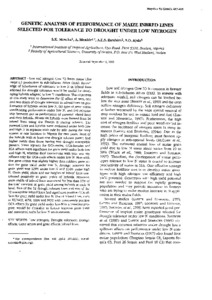| dc.contributor.author | Meseka, S.K. |
| dc.contributor.author | Menkir, A. |
| dc.contributor.author | Ibrahim, A.E. |
| dc.contributor.author | Ajala, S.O. |
| dc.date.accessioned | 2019-12-04T11:18:09Z |
| dc.date.available | 2019-12-04T11:18:09Z |
| dc.date.issued | 2006 |
| dc.identifier.citation | Meseka, S.K., Menkir, A., Ibrahim, A.E. & Ajala, S.O. (2006). Genetic analysis of performance of maize inbred lines selected for tolerance to drought under low nitrogen. Maydica, 51(3-4), 487-495. |
| dc.identifier.issn | 0025-6153 |
| dc.identifier.uri | https://hdl.handle.net/20.500.12478/3074 |
| dc.description.abstract | Low soil nitrogen (low N) limits maize (Zea maysL.) production in sub-Saharan Africa (SSA). Knowledge of inheritance of tolerance to low N in inbred lines selected for drought tolerance would be useful for developing hybrids adapted to low N conditions. The objectives of this study were to determine the (i) effect of zero, oneand two doses of drought tolerance in inbred lines on performance of hybrids under low N, (ii) type of gene action conditioning performance under low N, and (iii) relationship between per se performance of parental inbred lines and their hybrids. Ninety-six hybrids were formed from 24 inbred lines using the Design II mating scheme. The parental lines and hybrids were evaluated under both low and high N in separate trials side by side during the rainy season at one location in Nigeria for two years. Most of the hybrids with at least one drought tolerant parent had higher yields than those having two drought susceptible parents. Mean squares for GCA-males, GCA-females and SCA effects were significant for grain yield under both low and high N, whereas their interactions with year was significant only for GCA-male effects under low N. Non-additive gene action was slightly higher than additive gene action for grain yield under low N. Average heterosis for grain yield was 129% under low N and 114% under high N. Grain yield, plant and ear heights of inbred lines contributed positively to grain yields of hybrids. However, grain yields of inbred lines accounted for less than 15% ofthe total variation in grain yield among hybrids at each N level. Five of the 12 drought tolerant lines and two of the 12 susceptible inbred lines had significant positive GCA effects for grain yield under low N. Use of inbred lines, such as KU1409, 4058, 1824 and 9432 with consistently positive GCA effects for grain yield under low-N in a breeding program would be desirable to further improve grain yield and associated traits for low N environments. |
| dc.language.iso | en |
| dc.subject | Low Nitrogen |
| dc.subject | Drought Tolerance |
| dc.subject | Dosage Effects |
| dc.subject | Gene Action And Gene Effects |
| dc.subject | Inbred Lines |
| dc.title | Genetic analysis of performance of maize inbred lines selected for tolerance to drought under low nitrogen |
| dc.type | Journal Article |
| dc.description.version | Peer Review |
| cg.contributor.affiliation | International Institute of Tropical Agriculture |
| cg.contributor.affiliation | University of Gezira |
| cg.coverage.region | Africa |
| cg.coverage.region | West Africa |
| cg.coverage.region | North Africa |
| cg.coverage.country | Nigeria |
| cg.coverage.country | Sudan |
| cg.isijournal | ISI Journal |
| cg.authorship.types | CGIAR and developing country institute |
| cg.iitasubject | Diseases Control |
| cg.iitasubject | Plant Diseases |
| cg.iitasubject | Farm Management |
| cg.iitasubject | Genetic Improvement |
| cg.iitasubject | Maize |
| cg.iitasubject | Livelihoods |
| cg.iitasubject | Food Security |
| cg.iitasubject | Handling, Transport, Storage And Protection Of Agricultural Products |
| cg.iitasubject | Plant Production |
| cg.iitasubject | Agribusiness |
| cg.iitasubject | Plant Breeding |
| cg.iitasubject | Pests Of Plants |
| cg.iitasubject | Plant Genetic Resources |
| cg.accessibilitystatus | Limited Access |
| local.dspaceid | 94540 |

